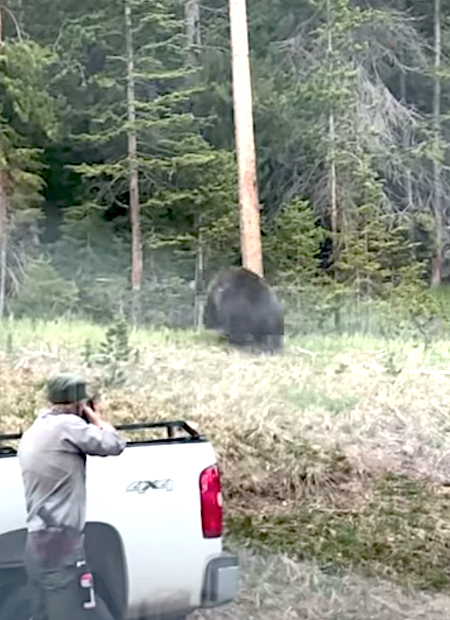
A grizzly boar that charged out of the woods towards Yellowstone visitors was hazed back into the woods by a ranger/Jay Dawg via YouTube
A Yellowstone National Park ranger averted potential tragedy by firing rubber bullets and "cracker shells" to stop a grizzly that charged onlookers who failed to maintain a safe distance from the bear.
A video of the incident captured by Jay Dawg shows the ranger trying to stop traffic and get onlookers hoping to capture a photograph of a pair of grizzlies to move away.
When the grizzly boar bounded out of the woods between Norris Junction and Swan Lake Flat and rose up on its hind legs to look around at the people, the ranger darted back to his truck, pulled a shotgun, shouted at the bear, and fired a few rounds in its direction to get the bruin to reverse course and head back into the woods.

The ranger resorted to firing rubber bullets and "cracker shells" at the bear/Jay Dawg via YouTube
The incident last Friday night came the same day that a lone hiker was attacked by another grizzly on the Beaver Ponds Trail near Mammoth Hot Springs.
"We've already seen numerous close calls with bears this year, and had one visitor seriously injured last week," Yellowstone Superintendent Cam Sholly told the Traveler on Wednesday. "Visitors need to maintain appropriate distances to wildlife and understand these animals are wild and can kill or injure humans very easily if threatened.
"The resource management technician in the video did an excellent job of hazing the aggressive bear away from visitors who obviously had no clue what kind of danger they were in," the superintendent added. "His actions likely saved lives. Non-lethal bean bags and rubber bullets were used in this situation, and are some of the tools we use to haze wildlife away from visitors."
Park regulations call for visitors to remain at least 100 yards away from bears, but in this case some were within 20 yards, according to park staff.



Comments
It looks like he is favoring his front paw. An injured animal is a dangerous animal. And with grizzlie, multiply that 10x!
Humans are the stupidest animals by far..
Left front paw is definitely injured. The bear won't put any weight on it. Hope they got a vet to tranquilize it and see what happened to that paw. Then getting it to heal is another big problem with a wild bear who is not likely to tolerate a cast. zOr crutches!!
In the Everglades, we had alligators that would approach picnickers and boaters because foolish visitors had been feeding them. We had one visitor bitten by a 9-footer because he didn't realize how fast one could move after he kicked it. ANd the stories go on and on.
That will get the heart rate up.
I don't pretend to know the dynamics of Ranger / Visitor interactions but would hope those that got too close at least received a written warning if not a ticket and fine.
I hope this parent who took the video explained to his child that it's not a laughing matter. It was a very dangerous situation!
National parks can not wildlife when injured. Nature has to heal and help animals. Humans stay out of their homes. Leave them live a great life without us disturbing them. Enjoy there beauty.
Tell kid It's not a teddy bear
It's a bear with an injured left foot. People disturbing it makes it. Mad. It wants to go to water across road. But road has 2.many cars.
Enjoy all wildlife at distance. Take home memories and.photos.